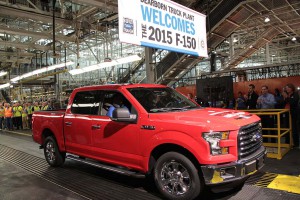
University of Michigan economists predict U.S. new vehicle sales will hit 17 million units in 2016. As the economy recovers, sales of trucks are going to grow.
The expansion U.S. economy next will boost sales of new vehicles and set the stage for industry-wide sales, reaching 17 million units in 2016, according to a new forecast the economists at the University of Michigan.
The economy will grow by more than 3% next year — its highest rate in 10 years, they added. The university auto sales numbers of 16.6 million in 2015 and 17 million the following year add to the chorus of predictions for a sustained stretch of prosperity for the industry.
By and large, automakers appear comfortable with the predictions of strong, steady sales over the next couple of years.
Toyota has already raised its sales forecast for next year, while Joe Eberhardt, president of Jaguar Land Rover North America, said during the week Los Angeles Auto Show preview that he is comfortable with the predictions the strong sales will continue.
James O’Sullivan, president and chief executive officer of Mazda North American Operations, also said the coming year looks good.
“In August, the light vehicle sales pace was the best since January 2006,” Hall said. “The truck sales share has averaged more than 53% so far this year, reflecting the strength of small CUV sales and an influx of new truck and SUV models from domestic manufacturers. The sales share of cars made overseas has declined over the summer, reflecting increases in North American production of several popular car models.”
The news isn’t just good for the auto industry.
“We expect that 2015 will be the year when U.S. economic growth will finally accelerate meaningfully,” said U-M economist Daniil Manaenkov in a statement. “This year, severe winter weather joined the list of headwinds that have prevented U.S. economic growth from picking up.
“Even still, both private and total payroll job gains during 2014 are on track for their best performance since 1999. And going forward, strong GDP growth supports steady employment gains.”
Overall economic output growth (as measured by real Gross Domestic Product) will jump from 2.2% this year to 3.1% in 2015 and 3.3% in 2016, according to Manaenkov and Matthew Hall of U-M Economics Department’s Research Seminar in Quantitative Economics.
(New vehicle buyers gobble up trucks, SUVs, luxury cars. For more, Click Here.)
In another promising sign for the U.S. economy, they predict the creation in the U.S. of 5.3 million jobs over the next two years—2.7 million jobs next year and another 2.6 million during 2016. Historically growth in employment translates into additional vehicle sales.
Net creation of 10.3 million jobs from 2013 through 2016 will be the best four-year stretch since 1997-2000, they say. Accordingly, unemployment will continue to fall to 5.4% by the end of next year and to 5% by the end of 2016, according to the U-M forecasting team.
“We believe that growth is more than ready to accelerate,” Manaenkov said. “The housing sector is on a more solid footing, well-positioned for growth. The unemployment rate dipped below 6% and is likely to keep falling, nudging higher wage growth. The industrial capacity utilization rate is close to normal, which bodes well for investment.
(Click Here for more about Volvo’s new V60 wagon.)
“Despite the change in Senate control, fresh rounds of harsh fiscal austerity are unlikely, and in spite of the projected start of interest rate tightening in 2015, the overall monetary policy stance is likely to remain loose for the duration of our forecast.”
In addition to GDP and employment growth over the next two years, the forecast calls for “a housing market poised to continue its long recovery from the depths of recession,” despite slowly rising mortgage rates, which are expected to hit 5% by the end of 2016 for 30-year conventional mortgages.
(To see more about Mitsubishi’s new XR-PHEV hybrid plug-in, Click Here.)
Construction of new homes – also an indicator of rising auto sales, particularly trucks – will continue to rise from a million units this year to more than 1.2 million next year and nearly 1.5 million in 2016. Sales of existing single-family homes are expected to increase from less than 4.4 million this year to nearly 4.7 million in 2015 and about 4.8 million in 2016.
Gas prices, the economists say, should remain relatively stable as the price of oil holds steady around $79-$80 per barrel through 2016. In addition, both consumer price inflation and core inflation, which excludes food and energy costs, will stay below 2% through 2016.
